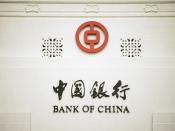The Reserve Bank, the central bank of Australia, has a significant effect on our individual lives as well as on the national and international banking system. In the process of carrying out monetary policy, the Reserve Bank influences employment, interest rates, the availability of credit, and even our standard of living. A remark by the chairman of the board of Governors of the Reserve Bank can cause public reaction and affect the stock market worldwide. (W S Weerasooria, 1996, p61) In recent years, the Reserve Bank has taken on an increasingly larger role in the financial system.
Role of Reserve Bank of Australia
lReserve Bank As Banker
One of the original roles of the Reserve Bank was to provide basic banking service to member banks. The Reserve Bank of Australia leaves deposit business and lending transactions with the corporations and individuals of the general public to financial institutions in the market, and concentrates instead on being a "bank of banks".
(G. Jay Francis, Susan M. Siegel, 2001, p41) Banks maintain Exchange Settlement Accounts with the Reserve Bank. These accounts are used to settle balances between banks arising from clearances of cheques. They are used to settle transactions between the banks and reserve Bank, arising from purchases and sales of government securities, foreign exchange and Australian notes and coin. The RBA has a banker-customer relationship with each of the nine companies it has authorized as dealers in the short-term money market and provides each with a line of credit to assist its liquidity.
The Reserve Bank Act directs the Bank, insofar as the Commonwealth requires it to do so, to act as banker and financial agent of the Commonwealth. (W S Weerasooria, 1996, p67) The Reserve Bank provides a comprehensive range of banking services to the Commonwealth, Governments of States.
The Reserve Bank maintains accounts in Australia currency for Australian depository for the International monetary Fund, Asian Development Bank and the International Bank for Reconstruction and Development (World Bank), and as their banker in Australia, arranges the exchanged transactions against Australian currency, which they may require in the course of their operations. (C.B. Schedvin, 1992, p546)
lReserve Bank as a bank of issue
The RBA is the sole issuing authority for Australian currency notes. The Reserve Bank Act provides for the issue, re-issue and cancellation of Australian notes to be effected. (W S Weerasooria, 1996, p68) The value of notes on issue depends on the community's demand and fluctuates substantially as a result of seasonal and other factors. The Reserve Bank plays a coordinating role in distribution of notes and coin to individual branches of these banks.
lPropose official interest rate
In Australia the Reserve Bank of Australia sets official interest rates, which are the interest rates paid on large-denomination overnight deposits in the official short-term money market. (Tom V, Guy F, Richard C, 2003, P219) The RBA announces the rate that it wants to achieve and then allows the amount of cash in the system to adjust so that it is consistent with the new interest rate. The RBA chooses this operational approach in order to reduce the volatility of interest rates. The private sector demand for cash varies from day to day in a way that is not fully predictable and, if the RBBA set the money base the interest rate world has to adjust to the daily shift in demand. The RBA adjusts the amount of cash in the system through its market operations-buying and selling government bonds or foreign currency.
lForeign Exchange
Australia has a floating exchange rate. This has been the case since 9 December 1983 when the Treasurer announced that the Australian dollar was being allowed to float and that virtually all exchange controls were being removed. (Tom V, Guy F, Richard C, 2003, P296) The Reserve Bank buys and sells foreign currencies in the market for several purposes. In its day-to-day operations, it seeks to enhance the efficiency of the market--by satisfying itself about the strength of market pressures or smoothing the passage of larger transactions through the market. It may trade one foreign currency for another in managing its international reserves. It also buys and sells foreign exchange to meet the requirements of clients, principally the Commonwealth Government. The Reserve Bank's market transactions in foreign exchange have effects on the exchange rate.
lDebt management
Debt management is concerned with financing the Commonwealth Government's deficit and refinancing its maturing debt. The Reserve Bank and the Treasury jointly advise the Commonwealth Government on its loan-raising program. (Tom V, Guy F, Richard C, 2003, P46) The RBA conducts inscribed stock registries, on behalf of the Commonwealth, and generally facilitates the marketing and management of the Commonwealth 's domestic loan-raisings.
lMarket Operation
The Reserve Bank operates in financial markets to influence the availability and cost of funds. Over time, this affects the demand for money and credit and spending levels in the community. The RBA undertakes transactions in the secondary market for Commonwealth Government securities. (Tom V, Guy F, Richard C, 2003, P228) Sales of securities, other things being equal, reduce the volume of liquid funds in the system and tighten monetary conditions. Purchases of securities have the opposite effects.
lPrudential Supervision of Banks
The Reserve Bank exercises prudential supervision over the operations of banks subject to the Banking Act. (W S Weerasooria, 1996, p63) The Banking Act imposes a duty on the Reserve Bank in relation to protection of the depositors of banks, which are subject to the Act. This duty, together with the Reserve Bank's general responsibilities for the stability of the financial system, provides the basis of the role in banking supervision. The Banking Act gives the Bank power to obtain information relating to the financial stability of a bank. The RBA seeks, in consultation with banks, to establish a framework of prudential standards within which individual banks might exercise their commercial judgments.
Compare with the Hong Kong Monetary Authority
The Hong Kong Monetary Authority (HKMA) was established on 1 April 1993 by merging the Office of the Exchange Fund with the Office of the Commissioner of Banking. Its main functions and responsibilities are governed by the Exchange Fund Ordinance and the Banking Ordinance and it reports to the Financial Secretary.
The HKMA is an integral part of the Hong Kong SAR Government. The Chief Executive, appointed by the Financial Secretary, remains a public officer, as does his staff. The Financial Secretary is advised by the Exchange Fund Advisory Committee (EFAC) on matters relating to the use of the Exchange Fund and the operation of the HKMA. The Committee functions very much as a management board of the HKMA and, among other things, advises the Financial Secretary on the HKMA's annual budget. The HKMA is accountable to the public through the Financial Secretary, who appoints the Monetary Authority, and through the laws passed by the Legislative Council that set out the HKMA's powers and responsibilities.
The functions and objectives of the HKMA are:
* To maintain currency stability, within the framework of the linked exchange rate system, through sound management of the Exchange Fund, monetary policy operations and other means deemed necessary;
* To promote the safety and stability of the banking system through the regulation of banking business and the business of taking deposits, and the supervision of authorized institutions; and
* To enhance the efficiency, integrity and development of the financial system, particularly payment and settlement arrangements.
These functions and objectives are generally common to the Reserve Bank of Australia. Unlike the Reserve Bank of Australia, however, the HKMA does not carry out the function "Banknote Issue". The HKMA has given authorization to three commercial banks, the Hong Kong and Shanghai Banking Corporation Limited, the Standard Chartered Bank and the Bank of China, to issue currency notes in Hong Kong. (Thomas Mayer, James S. Duesenberry, Robert Z. Aliber, 1993, p195) When the note-issuing banks issue banknotes, they are required by law to purchase Certificates of Indebtedness, which serve as backing for the banknotes issued, by submitting an equivalent amount of US dollars at the convertibility rate of HK$7.80 to one US dollar to the HKMA for the account of the Exchange Fund. The Hong Kong dollar banknotes are therefore fully backed by US dollars held by the Exchange Fund. Similarly, when Hong Kong dollar banknotes are withdrawn from circulation, the note-issuing banks redeem Certificates of Indebtedness and receive back an equivalent amount of US dollars from the Exchange Fund. In the case of coins, which are issued by the HKMA, transactions between the HKMA and the agent bank responsible for storing and distributing the coins to the public are settled against US dollars at the rate of HK$7.80 to one US dollar.
Although the bulk of the fiscal reserves are held by the Exchange Fund, which is managed by the HKMA, the HKMA does not act as the banker to the Government, a function which has been carried out historically by commercial banks. This is another difference between RBA and HKMA.
Hong Kong's linked exchange rate system has been in effect since 17 October 1983. Under the system, the Hong Kong dollar is linked to the US dollar at the rate of HK$7.80 to one US dollar. It has withstood a number of tests since its inception, including the 1987 stock market crash, the June 4 event in China in 1989, the Gulf war in 1990, the collapse of the BCCI in 1991, the ERM crisis in 1992, the Mexican currency crisis in 1994/95 and the Asian financial turmoil in 1997/98. In the face of these shocks, the Hong Kong dollar exchange rate has remained remarkably stable
The linked exchange rate system in Hong Kong is a currency board system, which requires both the stock and flow of the monetary base to be fully backed by the foreign reserves. This means that any change in the monetary base is fully matched by a corresponding change in foreign reserves at a fixed exchange rate. Because of the Hong Kong dollar is pegged to the US dollar and, as a result, Hong Kong interest rates must track US interest rate. (Thomas Mayer, James S. Duesenberry, Robert Z. Aliber, 1993, p177) That is the Hong Kong authorities have no control over their domestic monetary situation. The only way in which they could regain control would be to introduce restrictions on capital flows into and out of Hong Kong. But Australia has a floating exchange rate regime; the local authorities can run an independent domestic monetary policy.
Reference
C.B. Schedvin, In Reserve, Central Banking in Australia, 1945-75, Allen&Unwin, 1992
G. Jay Francis, Susan M. Siegel, Principles of Banking, An Overview of the Financial Services Industry, 7th ed, ABA, 2001
Thomas Mayer, James S. Duesenberry, Robert Z. Aliber, Money, Banking, and the Economy, 5th edition, W. W. Norton &Company, 1993
Tom V, Guy F, Richard C, Financial Markets and Institutions in Australia, Prentice Hall, 2003
W S Weerasooria, Banking Law and the Financial System in Australia, 4th edition, Butterworths, 1996
The Reserve Bank of Australia, http://www.abs.gov.au
The Hong Kong Monetary Authority, http://www.info.gov.hk


